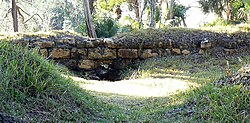
Wakulla County is a county located in the Big Bend region in the northern portion of the U.S. state of Florida. As of the 2020 census, the population was 33,764. Its county seat is Crawfordville.

St. Marks is a city in Wakulla County, Florida, United States. It is part of the Tallahassee metropolitan area. The population was 293 at the 2010 census. As of 2018, the population estimated by the U.S. Census Bureau is 319.

The Arkansas Post, formally the Arkansas Post National Memorial, was the first European settlement in the Mississippi Alluvial Plain and present-day U.S. state of Arkansas. In 1686, Henri de Tonti established it on behalf of Louis XIV of France for the purpose of trading with the Quapaw Nation. The French, Spanish, and Americans, who acquired the territory in 1803 with the Louisiana Purchase, considered the site of strategic value. It was the capital of Arkansas from 1819 until 1821 when the territorial government relocated to Little Rock.

The Castillo de San Marcos is the oldest masonry fort in the continental United States; it is located on the western shore of Matanzas Bay in the city of St. Augustine, Florida.
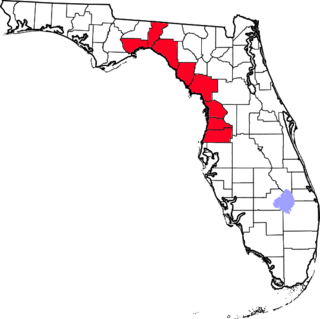
The Nature Coast is an informal, unofficial region of the U.S. state of Florida. The broadest definition of the Nature Coast includes the eight counties that abut the Gulf of Mexico along the Big Bend Coast defined by geologists: from west to east, Wakulla, Jefferson, Taylor, Dixie, Levy, Citrus, Hernando, and Pasco counties.
San Marcos is the Spanish name of Saint Mark. It may also refer to:
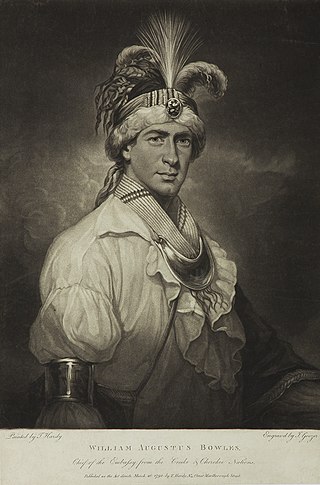
William Augustus Bowles (1763–1805), also known as Estajoca, was a Maryland soldier and adventurer. Seeing action as a Loyalist during the Revolutionary War, Bowles later formed an alliance with the Muscogee people and attempted to establish an independent indigenous American state with British support.
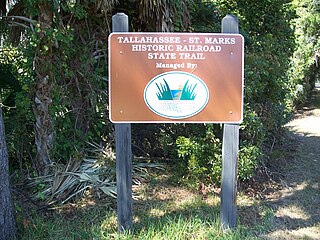
Tallahassee-St. Marks Historic Railroad State Trail is a rail trail and Florida State Park located on 16 miles (26 km) of the historic railbed of the Tallahassee Railroad, which ran between Tallahassee and St. Marks, Florida. The trail ends near the confluence of the St. Marks and Wakulla Rivers. The portion of the trail south of US 98 is designated as a portion of the Florida National Scenic Trail. A paved extension of the trail extends north for approximately 4 miles (6.4 km) into the City of Tallahassee.

Fort Ward was a Confederate States of America fort located in Wakulla County, Florida, at the confluence of the Wakulla River and St. Marks River and named after Colonel George T. Ward, owner of Southwood Plantation, Waverly Plantation, and Clifford Place Plantation south of Tallahassee. During the American Civil War, Confederate troops placed a battery of cannons at Fort Ward.
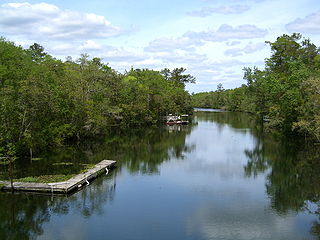
The St. Marks River is a river in the Big Bend region of Florida. It has been classified by the Florida Department of Environmental Protection as an Outstanding Florida Water, and is the easternmost river within the Northwest Florida Water Management District.
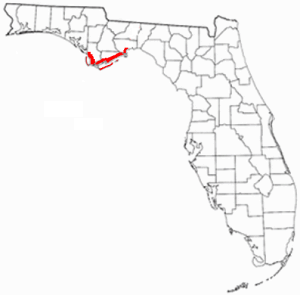
The Forgotten Coast refers to a largely untouched and uninhabited area of coastline in the panhandle of the US state of Florida. The term, also a trademark, was first used in 1992, but the Forgotten Coast's exact location is not agreed upon.

Mission San Luis de Apalachee was a Spanish Franciscan mission built in 1656 in the Florida Panhandle, two miles west of the present-day Florida Capitol Building in Tallahassee, Florida. It was located in the descendent settlement of Anhaica capital of Apalachee Province. The mission was part of Spain's effort to colonize the Florida Peninsula and to convert the Timucuan and Apalachee Indians to Christianity. The mission lasted until 1704 when it was evacuated and destroyed to prevent its use by an approaching militia of Creek Indians and South Carolinians.

The Big Bend of Florida, United States, is an informally-named geographic region of North Florida where the Florida Panhandle transitions to the Florida Peninsula south and east of Tallahassee. The region is known for its vast woodlands and marshlands and its low population density relative to much of the state. The area is home to the largest single spring in the United States, the Alapaha Rise, and the longest surveyed underwater cave in the United States, the 32-mile (51 km) Wakulla-Leon Sinks cave system.

Pike's Stockade is a historic exploration campsite located near Sanford, Colorado. Set on the north bank of the Conejos River, it is where explorer Zebulon Pike raised the American flag on Spanish soil in 1807. The site, now managed by Historic Colorado, includes a reconstruction of a wooden stockade, built according to Pike's detailed description of the original. The site was declared a National Historic Landmark in 1961.
Pablo de Hita y Salazar was a Spanish military officer who served as governor of Spanish Florida from 1675 to 1680. The territory at the time stretched from current-day Florida west to Texas and north to South Carolina. He was best known for his work devoted to construction of the Castillo de San Marcos in St. Augustine, the capital of La Florida.

St. Francis Barracks is a historic structure constructed of coquina stone located on Marine Street in St. Augustine, Florida, named in honor of St. Francis of Assisi. The barracks were constructed between 1724 and 1755 by friars of the Order of St. Francis, to replace a series of wooden buildings which had been destroyed by the ravages of the tropical climate in La Florida and by fire, both accidental fires and occasional intentional ones, such as when the city was razed by the English in 1702.
Lucas Fernando Palacios y Valenzuela was a military official who served as governor of Spanish Florida from 21 April 1758 to 6 December 1761.
Manuel de Cendoya was a Spanish soldier who served as governor of Spanish Florida from mid-1671 to mid-1673. His administration is remembered primarily for initiating construction of the Castillo de San Marcos, a masonry fortress whose building had first been ordered by Cendoya's predecessor, Governor Francisco de la Guerra y de la Vega, after the destructive raid of the English privateer Robert Searle in 1668. Work proceeded in 1671, although the first stone was not laid until 1672.
